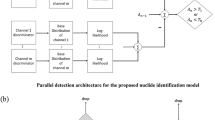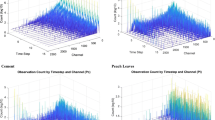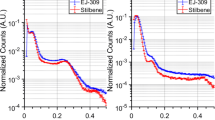Abstract
A rapid detection method based on sequential Bayesian analysis provides a new perspective on national security in preventing the smuggling and illegal transportation of nuclear materials. In this paper, a sequential Bayesian analysis system, which mainly consists of a LaBr3(Ce) scintillator detector, a pulse analyzer based on a field-programmable gate array technique, and a sequential Bayesian analysis processor, is developed to directly validate the feasibility of sequential Bayesian analysis. The detection ability of 60Co, 137Cs, 133Ba, and 152Eu for a specific radioactivity is studied and quantified using the maximum detection distance and the equivalent minimum detection activity.
















Similar content being viewed by others
References
Candy JV (2010) Detection, classification, and estimation of radioactive contraband from uncertain low-count measurements. LLNL Report: LLNL-TR-438632
Chambers DH (2008) Signal-processing model for radiation transport. IEEE Trans Nucl Sci 1:149–150
Candy JV, Breitfeiler EF, Guidry BL, Manatt D, Sale KE, Chambers DH, Axelrod MA, Meyer AM (2009) Radioactive Contraband Detection: A Bayesian Approach, Proceedings of MTS-IEEE Oceans 2009 Conference
Candy JV (2012) Sequential bayesian detection: a model-based approach, classical, semi-classical and quantum noise. Springer, Berlin, pp 9–18
Candy JV, Breitfeiler EF, Guidry BL, Manatt D, Sale KE, Chambers DH, Axelrod MA, Meyer AM (2009) Physics-based detection of radioactive contraband: a sequential Bayesian approach. IEEE Trans Nucl Sci 56(6):3694–3711
Candy JV, Chambers DH, Breitfeiler EF, Guidry BL, Verbeke JM, Axelrod MA, Sale KE, Meyer AM (2010) Model-based detection of radioactive contraband for harbor defense incorporating Compton scattering physics. Proceedings of Oceans 2010 IEEE Conference
Kumar GA, Mazumdar DA, Gothe DA (2009) Efficiency calibration and simulation of a LaBr 3(Ce) detector in close-geometry. Nucl Instrum Method Phys Res A 609(2–3):183–186
Xiang QP, Tian DF, Zhu JY, Hao FH, Ding G, Zeng J (2013) Numerical study on the sequential Bayesian approach for radioactive material detection. Nucl Instrum Method Phys Res A 697:107–113
Xiang QP, Tian DF, Hao FH, Ding G, Zeng J, Luo F (2013) Off-line experiments on radionuclide detection based on the sequential Bayesian approach. Nucl Instrum Method Phys Res A 729:212–219
Wald A (1945) Sequential tests of statistical hypothesis. Ann Math Stat 16:117–186
Xiang QP, Hao FH, Lei JR, Chen HD, Chu CS, Cao L (2012) Research on performance of lanthanum bromide(Ce) scintillator detector. J Appl Nucl Sci & Technol 5(2):131–136
Xiang QP, Tian DF, Hao FH, Chu CS, Ding G, Zeng J, Luo F (2014) Self-calibration method for cerium-doped lanthanum bromide scintillator detector in the 0.1–2.0 MeV energy range. J Radioanal Nucl Chem 299:1439–1445
Herman M (1986) National Nuclear Data Center. http://www.nndc.bnl.gov
Iltis A, Mayhugh MR, Menge P, Rozsa CM, Selles O, Solovyev V (2006) Lanthanum halide scintillators: properties and applications. Nucl Instrum Method Phys Res A 563:359–363
Milbrath BD, Choate BJ, Fast JE, Hensley WK, Kouzes RT, Schweppe JE (2007) Comparison of LaBr 3: Ce and NaI: Tl scintillators for radioisotope identification devices. Nucl Instrum Method Phys Res A 572(2):774–784
Alzimami K, Abuelhia E, Podolyak Z, Ioannou A, Spyrou NM (2008) Characterization of LaBr 3: Ce and LaCl3: Ce scintillators for gamma-ray spectroscopy. J Radioanal Nucl Chem 278(3):755–759
Sullivan JP, Rawool-Sullivan MW, Wenz TR (2008) LaCl3(Ce) and LaBr 3(Ce) gamma-ray spectra with various plutonium isotopic and uranium enrichment standards. J Radioanal Nucl Chem 276(3):699–705
Acknowledgments
Very sincere thanks are due to Mr. Dai Fei, Dr. Zhou Rong, and Prof. Yang Chaowen from Sichuan University. This Project was supported by the Foundation for Development of Science and Technology of China Academy of Engineering Physics (Grant No. 2013B0103005).
Author information
Authors and Affiliations
Corresponding author
Appendices
Appendix energy distribution and estimator
The full-peak energy of the jth monoenergetic source of the mth radionuclide under the observations X m,j (n−1) is typically a Gaussian distribution as following
If H 1 is true, the mean and standard deviation are the true parameters denoted by superscript t, and if H 0 is true, the mean and standard deviation are estimated parameters (denoted by superscript ^) which should be sequentially innovated by evaluating the measurement up to the nth event. The energy estimator proposed [5] is base on the Gauss-Markov representation as
where ω ε ~ N(0, R ωω ) is an uncorrelated zero-mean, Gaussian noise, mainly depending on the shield system uncertainty and ν ε ~ N(0, R νν ) is the measurement (instrumentation) noise. For the Kalman filter achieves a minimum variance estimate in the linear Gauss-Markov model case so that it is utilized as the optimal estimator in energy estimation. The algorithms of the Kalman filter are
-
(1)
Initialize: \( \epsilon_{m,j}^{ \wedge } (0|0) =\epsilon _{m,j}^{t} ,R_{{\epsilon_{m,j}^{ \wedge } }} (0|0) = = \sigma_{{\epsilon_{m,j}^{t} }}^{2} \)
-
(2)
Prediction: \( \epsilon_{m,j}^{ \wedge } (n|n - 1) = \epsilon_{m,j}^{ \wedge } (n - 1|n - 1) \)
-
(3)
\( R_{{\epsilon_{m,j}^{ \wedge } }} (n|n - 1) = R_{{\epsilon_{m,j}^{ \wedge } }} (n - 1|n - 1) + R_{\omega \omega } (n - 1) \)
-
(4)
Innovation: \( e_{m,j} (n) = \varepsilon_{m,j} (n) - \epsilon_{m,j}^{ \wedge } (n|n - 1),R_{ee} (n) = R_{{\epsilon_{m,j}^{ \wedge } }} (n|n - 1) + R_{\nu \nu } (n) \)
-
(5)
Gain coefficient: \( K_{m,j} (n) = R_{{\epsilon_{m,j}^{ \wedge } }} (n|n - 1) \times R_{ee}^{ - 1} (t) \)
-
(6)
Correction: \( \epsilon_{m,j}^{ \wedge } (n|n) = \epsilon_{m,j}^{ \wedge } (n|n - 1) + K_{m,j} (n) \times e_{m,j} (n) \)
$$ R_{{\epsilon_{m,j}^{ \wedge } }} (n|n) = [1 - K_{m,j} (n)] \times R_{{\epsilon_{m,j}^{ \wedge } }} (n|n - 1) = \sigma_{{\epsilon_{m,j}^{ \wedge } }}^{2} (n) $$
Interarrival time distribution and estimator
The interarrival time for the jth monoenergetic source of the mth radionuclide under the observations X m,j (n−1) and current event’s energy ε m,j (n) is exponentially distributed as
If H 1 is true, the mean interarrival time is theoretically calculated based on the specific model of radionuclide detection, and if H 0 is true, the mean interarrival time is also estimated by evaluating the measurement up to the nth event using particle filter rather than the Kalman filter because of the nonlinear property of the interarrival time estimation. The interarrival time estimation model is
The noise source \( \omega_{{\Delta \tau_{m,j} }} \sim f_{\omega } (\omega_{{\Delta \tau_{m,j} }} ) = \lambda_{m,j}^{t} \exp ( - \lambda_{m,j}^{t} \times \omega_{{\Delta \tau_{m,j} }} ),\lambda_{m,j}^{t} = 1/\Delta \tau_{m,j}^{t} \) and \( \nu_{{\Delta \tau_{m,j} }} \) is exponential measurement (instrumentation) noise which depends on the time measurement accuracy of experimental instruments with the probability density as \( f_{\nu } (\nu_{{\Delta \tau_{m,j} }} ) = \lambda_{\nu } \exp ( - \lambda_{\nu } \times \nu_{{\Delta \tau_{m,j} }} ) \). The corresponding conditional probability with the state prediction \( \Delta \tau_{m} (n) \) is\( f_{\nu } (\Delta \tau_{m} (n)|\Delta \tau_{m} (n)) = \lambda_{\nu } \exp [ - \lambda_{\nu } \times (\Delta \tau_{m} (n) - \Delta \tau_{m} (n))] \). In this project, the particle filter is utilized to estimate the maximum a-posterior (MAP) distribution of interarrival time. The algorithms of particle filter are
-
(1)
Initialize: \( \Delta \tau_{m,j}^{ \wedge } (0) = \Delta \tau_{m,j}^{t} = 1/\lambda_{m,j}^{t} \), sampling N p pairs of {particle, weight}
$$ \Delta \tau_{m,j}^{(i)} = \omega_{{\Delta \tau_{m,j} }} (0)\sim \lambda_{m,j}^{t} \exp ( - \lambda_{m,j}^{t} \times \omega_{{\Delta \tau_{m,j} }} ),W_{m,j}^{(i)} (0) = 1/N_{p} ,\quad i = 1,2, \ldots ,N_{p} $$ -
(2)
Prediction: \( \Delta \tau_{m,j} (n) = \Delta \tau_{m,j}^{(i)} + \nu_{{\Delta \tau_{m,j} }} (n), \quad i = 1,2, \ldots ,N_{p} \)
-
(3)
\( {\text{Likelihood: }} f_{\nu } (\Delta \tau_{m,j} (n)|\Delta \tau_{m,j}^{(i)} ) = \lambda_{\nu } \exp [ - \lambda_{\nu } \times (\Delta \tau_{m,j} (n) - \Delta \tau_{m,j}^{(i)} )], \quad i = 1,2, \ldots ,N_{p} \)
-
(4)
Weight update: \( \begin{aligned} W_{m,j}^{(i)} (n) & = W_{m,j}^{(i)} (n - 1) \times f_{\nu } (\Delta \tau_{m,j} (n)|\Delta \tau_{m,j}^{(i)} ) \\ & =W_{m,j}^{(i)} (n - 1) \times \lambda_{v} \exp [ - \lambda_{v} \times (\Delta \tau_{m,j} (n) - \Delta \tau_{m,j}^{(i)} )], \quad i = 1,2, \ldots ,N_{p} \\ \end{aligned} \)
-
(5)
Weight normalization: \( {{W_{m,j}^{(i)} (n) = W_{m,j}^{(i)} (n)} \mathord{\left/ {\vphantom {{W_{m,j}^{(i)} (n) = W_{m,j}^{(i)} (n)} {\sum\nolimits_{i = 1}^{{N_{p} }} {W_{m,j}^{(i)} (n)} ,i = 1,2, \ldots ,N_{p} }}} \right. \kern-0pt} {\sum\nolimits_{i = 1}^{{N_{p} }} {W_{m,j}^{(i)} (n)} , \quad i = 1,2, \ldots ,N_{p} }} \)
-
(6)
MAP estimate: \( \Delta \tau_{m,j}^{ \wedge } (n) = \Delta \tau_{m,j}^{(k)} ,W_{m,j}^{(k)} (n) = \mathop {\hbox{max} }\limits_{{1 \le i \le N_{p} }} W_{m,j}^{(i)} (n) \Rightarrow \lambda_{m,j}^{ \wedge } (n) = 1/\Delta \tau_{m,j}^{ \wedge } (n) \)
Normalized detection probability estimator
According to the definition mentioned above in Eq. (5), the normalized detection probability as the function of detection efficiency, photoelectric effect probability and emission probability corresponding to all monoenergetic sources of the mth radionuclide can be described as
Meanwhile, a sequential counting technique is used to obtain the estimated normalized detection probability. The sequential counting estimator for the jth monoenergetic source of the mth radionuclide is given by
where M m,j (n) is the total counts of full energy events for the jth monoenergetic source of the mth radionuclide at arrival time n.
Rights and permissions
About this article
Cite this article
Xiang, Q., Wang, Z., Tian, D. et al. On-line experiments on rapid detection of radionuclides based on sequential Bayesian analysis. J Radioanal Nucl Chem 306, 57–70 (2015). https://doi.org/10.1007/s10967-015-4072-y
Received:
Published:
Issue Date:
DOI: https://doi.org/10.1007/s10967-015-4072-y




